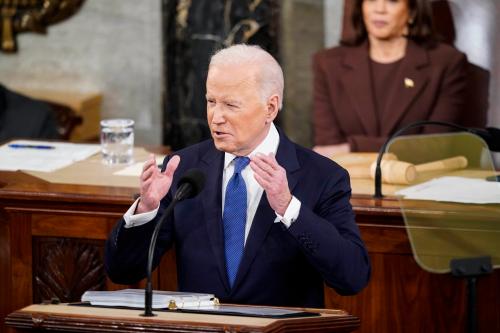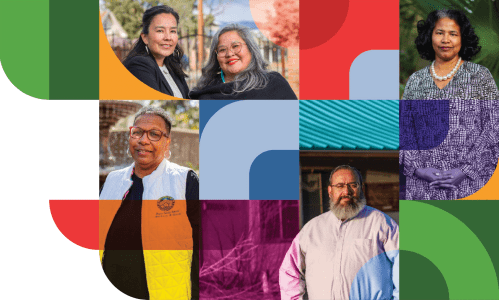It might be the most important Commission you haven’t heard of – or at least not yet. Created by bipartisan legislation in August 2020, the Commission on the Social Status of Black Men and Boys is now up and running. Not a moment too soon. The specific, unique challenges faced by Black men and boys are in the spotlight. Both President Joe Biden and Vice President Kamala Harris have explicitly called attention to how their policies can “empower Black men.” But more tailored policies are also needed.
“To be male, poor, and African American…is to confront, on a daily basis, a deeply held racism that exists in every social institution,” writes our Brookings colleague Camille Busette.
The obstacles facing Black boys and men are a central concern of both the Race, Prosperity and Inclusion Initiative and the Boys and Men Project here at Brookings, and of much of our previous work: see for example “The challenges facing Black men – and the case for action”, “The inheritance of Black poverty: It’s all about the men” and “Long shadows: The Black-white gap in multigenerational poverty”.
The new institution is a 19-member permanent Commission within the United States Commission on Civil Rights, charged with investigating “potential civil rights violations affecting Black males” and “studying the disparities they experience in education, criminal justice, health, employment, fatherhood, mentorship and violence.” Modeled on a similar initiative in Florida, the Commission is required by law to report annually to Congress with policy recommendations and advice.
So where should the new Commission focus its energy and attention? The law establishing the Commission explicitly names five key areas of interest: education; justice and civil rights; healthcare; labor and employment; and housing. But of course, even these are exceptionally large topics. Our hope is that the Commission will lean heavily towards solutions. In that spirit, we offer here a range of policy ideas to consider under each of the five headings, many drawn from the work of Brookings scholars, that the Commission should consider.
Education
Black boys and men are overrepresented among those with lower levels of education and training, which damages their opportunities in the labor market. There are proposals on this front to:
- Offer financial incentives to get more Black teachers, especially men, into our schools.
- Build networks for Black male teachers to improve retention rates.
- Improve systems for awarding grades in schools to remove racial bias.
- Shift resources in schools from policing to social work, health care and counselling.
- Increase vocational and technical training for formerly incarcerated adults.
- Require states to share data on high school graduation rates by race and
Justice and Civil Rights
Black men consistently face greater surveillance, policing and contact with the criminal justice system. There are proposals here to:
- Increase the liability of police officers that engage in misconduct.
- Expunge cannabis-related criminal records, which disproportionately impact Black men.
- Provide federal student financial aid to those with prior drug convictions.
- End disenfranchisement of the formerly incarcerated.
- Shift civilian payouts from taxpayer money to police department insurance policies.
- Pursue strategies to abolish mass-incarceration and the criminalization of Black men.
- Extend President Obama’s solitary confinement reform to non-federal prisons.
Healthcare
Black men have suffered the highest rates of mortality from Covid-19 according to many studies. As our colleague Keon Gilbert writes, “the health of black men consistently ranks lowest across nearly all groups in the United States.” There are proposals here to:
- Guarantee access to COVID-19 vaccines by organizing national outreach.
- Expand telehealth to improve Black men’s ability to access trustworthy healthcare.
- Enforce the Environmental Justice Executive Order.
- Expand community health centers to foster trust and improve health outcomes.
- Improve Medicaid reimbursement rates for mental health services.
- Recruit Black men as counselors, social workers, and mental health workers in schools.
Labor and Employment
Black men have seen the slowest wage growth of any demographic group in recent decades, and are at a high risk of unemployment. There are proposals here to:
- Incentivize Black men to take up jobs in fast-growing “HEAL” sectors.
- Bolster and broaden the role of unions and collective bargaining to close pay gaps.
- Pressure large companies to reform their hiring practices to be more inclusive.
- Reform the child support system which disproportionately hurts Black fathers.
- Expand the Earned Income Tax Credit (EITC) to cover non-residential parents.
- Regulate employment algorithms to prevent racial discrimination in hiring processes.
Housing (and wealth)
There is a wide racial wealth gap, at both individual and household levels. Both Black men and Black women have very low levels of wealth especially compared to white men and women. There are proposals here to:
- Revalue Black assets, especially Black-owned businesses, housing, and other property.
- Encourage more inclusive policies from the real estate industry.
- Design financial advantages to support Black homeownership.
- Create baby bonds, providing every child at birth with a publicly-funded trust account.
- Subsidize individual development accounts (IDAs) for low-income households.
- Require banks to offer low-cost basic accounts.
- Partner with the Commission on Reparation Proposals for African-Americans.
Now or never
Obviously, this is not an exhaustive list. Some of the ideas here would represent significant change, others are incremental. Some are grounded in strong evaluation evidence already, others will need careful study. Assuming the Commission is as solutions-oriented as early indications suggest, this list of policy ideas provides at least a starting point for consideration. There’s a moment of opportunity here. Advancing racial justice remains central to the policy debate. Tackling the gendered racism faced by Black men is a critical step towards racial justice. The Commission has its work cut out as it is tasked to address deeply entrenched structural issues. But it is work that could hardly be more important.
The Brookings Institution is financed through the support of a diverse array of foundations, corporations, governments, individuals, as well as an endowment. A list of donors can be found in our annual reports published online here. The findings, interpretations, and conclusions in this report are solely those of its author(s) and are not influenced by any donation.








Commentary
What should the new Commission on the Social Status of Black Men and Boys propose? Here are 32 ideas for starters.
March 14, 2022